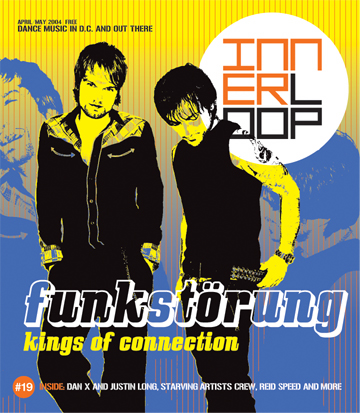Article on Funkstörung
Innerloop, April/May 2004
written by Jorge E. Bañales; edited by Christine Moritz
|
This article on Funkstörung was the cover story in the April/May 2004 issue of Innerloop, which was Washington, D.C.'s premier dance music magazine from its inception in 2002 until its passing in autumn 2004. Christine Moritz served as editor in chief of the magazine from February 2004 onwards. Download PDF version
of article with artwork (illustrations by Nils Davey) Cover design (right)
by Ivan Cottrell, Innerloop art director Article reprinted by permission from Innerloop. |
|
 |
|
Disconnected Pop Ever since Kraftwerk, Germans have had an affinity for taking American electronic music and pushing its boundaries. In “Disconnected,” their new full-length on Studio K7, Funkstörung’s Chris de Luca and Michael Fakesch take ingredients from hip-hop, blues, soul and folk rock to cook up a stew of glitch-hop, electro-soul and minimal tech-house. Though previously better known for their electronic instrumentals, in “Disconnected” the duo concentrates on a more organic effort with an emphasis on pop song structures, live instrumentation and vocals. “Pure electronic music was starting to bore us,” says Fakesch. “It was somehow no longer our thing and we had to free ourselves from this feeling. We have always had the use of vocals and acoustic instruments at the back of our minds, so we then searched intensively for instrumentalists.” For the new album, Funkstörung worked with about 30 musicians, including Enik, a 23-year-old vocalist and multi-intrumentalist; Lou Rhodes, the singer from Lamb; Sarah Jay, best known for her vocals on Massive Attack’s “Mezzanine”; MC Tes, a New York-based artist on Warp’s Lex Imprint; Rob Sonic, of New York hip-hop outfit Sonic Sum; Hamburg-based beatboxer Mark Boombastic; and pianist Matthias Modica, head of the Gomma label and a member of Munk. The album’s title refers not only to its decreased emphasis on digital beats, but also to the methods by which it was produced. Instead of recording face-to-face, De Luca and Fakesch and their collaborators from across the globe used a file transfer protocol (FTP) server to exchange tracks. Fakesch says candidly that working alongside other musicians is not Funkstörung’s strong suit. He and De Luca are perfectionists, taking “hours and hours and days and days” to find the right sound and get the right take. Outside feedback can hinder this process: “It feels wrong if somebody listens to us and comments on what we are doing.” Creative control is very important to the pair; though they gave singers and musicians great freedom to add to the instrumentals they placed on the FTP server, in the editing phase Funkstörung made the final decisions. The duo prize isolation not only in the studio, but also in the larger world. Based in Rosenheim, a small town in the German region of Bavaria, they feel that their geographic location helps insulate them from musical pressure. Fakesch says, “We just concentrate on what we are doing; nobody tells us, ‘Hey, you have to check out this new trend, you should go see this band.’ We are totally on our own. We are really isolated, which is good because it lets you concentrate on your music.” Hip-hop is one influence that Funkstörung has allowed into the studio. Several of the new album’s tracks, such as “Chopping Heads,” set raps over the group’s brand of techy hip-hop. Fakesch acknowledges this but maintains, “We didn’t need to live in America to get a hip-hop influence. You can find music anywhere.” In fact, he says, he and De Luca have been listening to hip-hop for over 15 years. The album’s title track is a metallic folk song in which the soulful Enik lazily describes surreal landscapes. “We always wanted to do pop songs,” says Fakesch, who notes that “Disconnected” was the first instrumental they wrote. After trying two other singers, they found the right combination with Enik, and as a result the track “became the prototype for the album.” Funkstörung say they chose it as a single because of the music, the lyrics, and the unusual vocal style. In this record there is less emphasis on programming than in previous Funkstörung outings; Fakesch and De Luca say they don’t know how their fans will react to this departure. They note, however, that their earlier remix work indicated a move in this direction. In addition, they say that they’ve always been open to working with vocals and acoustic instruments and have never concealed the fact that they liked pop music as well as hip-hop. With this album they took risks and were aware that some fans might turn away, but felt that it was important for them to develop their style. Fakesch sees a continuity despite the change, saying that the duo is proud that they “managed to find a new sound without losing our original Funkstörung flavor.” With “Disconnected,” the pair have brought their new vision to fruition: “We had a kind of picture in our heads [of] how the album should sound, and we worked extremely hard to meet this picture. We are very, very happy and proud that we managed to get really close to what we had in mind.”
Funkstörung plans to perform both older and newer material with a live band and a visual artist when they tour Europe in May and the United States and Japan in June. For more information on the project, see www.funkstorung.com. |